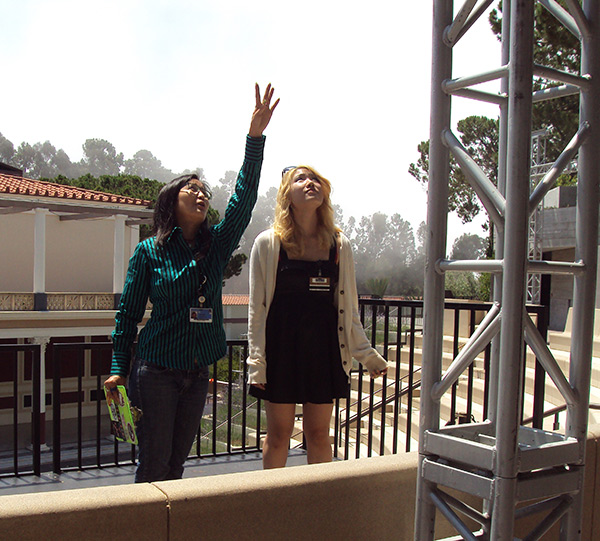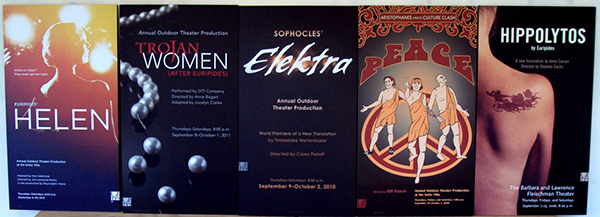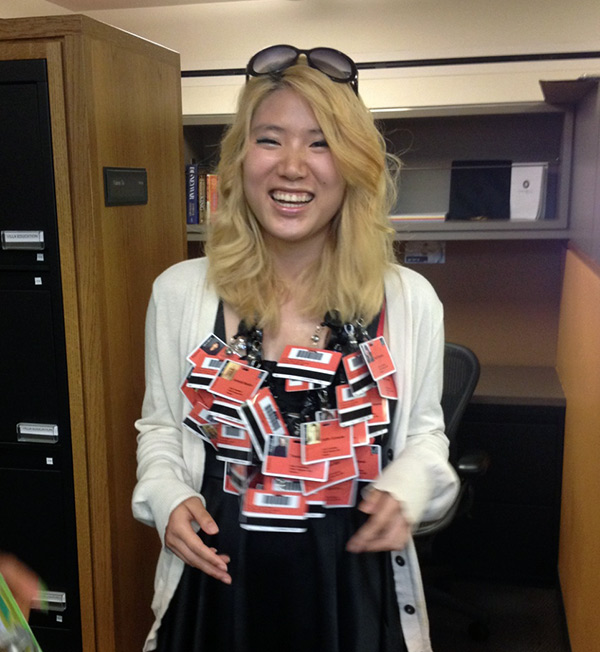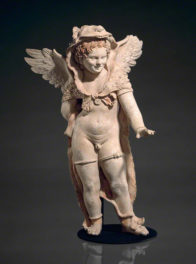
Inspecting the progress on the set preparations for this year’s Outdoor Classical Theater performance of Prometheus Bound. That’s me at right; at left, Anna Woo of the Villa theater team.
Throughout 2013, the Getty community participated in a rotation-curation experiment using the Getty Iris, Twitter, and Facebook. Each week a new staff member took the helm of our social media to chat with you directly and share a passion for a specific topic—from museum education to Renaissance art to web development. Getty Voices concluded in February 2014.—Ed.
Anyone who’s ever stayed through a movie’s credits to watch the blooper reel can guess, after the hilarity, at the sheer amount of work and manpower that goes into a production. The creation of a performance, whether a movie or a theatrical show, is a fluid process, and it requires a flexibility in its roles and responsibilities. This is especially true for the performances at the Getty Villa, a traditional—and yet untraditional—venue.
How’s this for a challenge? Take an ancient play written thousands of years ago and make it relevant and appealing to a modern audience used to quicker-than-quick storytelling and resolutions. What you may not know as an audience member is that the 90-minute performance for which you bought a ticket was planned a year or two before you saw a post on Facebook or heard about it on your local radio station. In fact, 2014’s plays are already in pre-production as you read these words.
So what exactly is the Getty production team doing during this long-in-advance planning period—other than meeting, reading, negotiating, researching, seeing shows, courting, declining, meeting again, and budgeting?
To begin, we’re looking for good ideas. Scouting an artist or a performance can start in any number of ways—from finding an interesting director, theater company, co-presenter, adapter, or translator, to scouring the Getty libraries for the perfect play for the perfect time. The seeds for Prometheus were planted in 2011 when CalArts, whose Center for the Art of Performance is our collaborator on this production, presented Piedra del Sol at the Villa.
(This demonstrates an important point about working in the theater community: a good working relationship can often lead to more collaborations down the road. Good lesson here: don’t burn bridges! Past collaborations are in fact the basis by which many of the Villa’s 2014 productions are being determined. However, with the large repertoire of performances the Villa presents each year, including both our outdoor production Villa Theater Lab and the Villa Play-Reading Series, it is also common for someone within the department to scout a director or company whose classical background would be a good fit. A show on a certain subject may also be chosen in association with an opening exhibit at the museum, involving the collaboration with the curatorial staff. Because of the wide variety of ways in which shows are developed, the Villa can boast an exciting lineup each year.)

Posters from past outdoor performances at the Getty Villa, from 2006’s inaugural play, Hippolytos (far right) to 2012’s Helen.
Despite its centuries-old lifespan, the script of Prometheus Bound is anything but ancient. To create a more contemporary version of the play, poet Joel Agee was contacted to helm a working translation. Script development by itself can take almost as long as the entire planning process of a show, even lasting to the day before its first performance. (Note to translator/adapter: Actors love it when you hand them ten new pages of script for memorization the night before a first preview. You’ll be their new BFF.)
Once the show is determined, the production process becomes more…well, theatrical (as if we’re lacking in that department). From casting to set design to rehearsals to catering, every step requires the input and creativity of several minds (sometimes many minds) across a multitude of departments and organizations.
Staging Prometheus Bound in the Outdoor Classical Theater presents an interesting challenge, since the setting of the play is a cliffside in Scythia. The original plan was to stage the performance on the seats of the outdoor theater, and to have the audience sit where the actors would traditionally perform. The scenic design of the show later developed into a 23-foot wheel, which allows the action to remain in its optimal location for an audience on stage, while also providing a unique spin on a stationary setting. Much of the creative process that occurs when producing a show consists of problem-solving and negotiating, while still holding on to artistic integrity.

Prometheus Bound‘s five-ton wheel will be lowered from the Fire Road into the Outdoor Classical Theater on July 16, 2013. Here, power washing is underway in preparation for the wheel’s arrival.
All manner of questions need to be asked and answered as soon as possible during every production, and usually between more than two people. Because the shows at the Getty Villa take place in a museum environment, we have to take into account how set pieces will be built while guests are visiting the museum, how the cast and crew can enter the museum on a daily basis, and when the venue will be clear for new exhibits. In a traditional theatrical setting, the show most clearly “comes together” during the cue-to-cue, when the lights and sounds are written and synced with the action of the performance. At this point, “process” becomes “procedure” in an effort to ensure that a performance can run as efficiently as possible. The behind-the-scenes action is like a giant web, connecting stage managers to security staff to musicians to ushers—and more.

AV staff setting up the tech booth in the Outdoor Classical Theater, July 2, 2013.
When the set pieces are finally loaded in, rehearsal days are running short, tempers are getting shorter, and the director’s notes are long. Suddenly it’s previews and opening night and we hope we have a full house.
And then there’s the question of how audience members end up in the seats. While making a production is a highly involved process, publicizing it is in and of itself a massive undertaking. It involves printing programs, writing magazine articles, contacting newspapers, interacting with social media, and even planning special menus for performance nights. This year, the Getty Villa is asking visitors to tag photos of themselves with #PrometheusWheel on Instagram and Twitter, as well as offering a special “Nectar of the Gods Sunset Celebration” dining option on Thursday nights. And while many museums and theater companies have departments dedicated specifically to publicity, this work involves the contributions of many people, from graphic designers to events managers.
The result is a combination of art, literature, social commentary, commerce, counseling, handholding, philosophy, paperwork, blood, sweat, and sometimes theatrical daggers and tears–as well as a special blend of crazy juice (created in-house by our own modern apothecary–a coffee-maker)–and then only available to the public for fifteen nights.
Even as you finish reading this article, we’re hard at work seeing this mission through and planning for 2016. More coffee, apothecary, PLEASE!!!

One of a summer theater intern’s many duties: collecting badges for the cast and crew of Prometheus Bound.




Here at Apollo Arts we are getting ready to perform our first Shakespeare festival that includes two plays, that run concurrently. We’re performing Romeo and Juliet and As You Like It with original (and superbly crafted) music, scored by Justin McKay. All your observations on how things come together ring familiar and true. We had our technical rehearsal last night and around 1AM we called it a day. Thanks Valerie – nice post.
Hi George–
It’s great to hear from another voice in theater! We’re no strangers to working late nights; in fact, as exhausting as they are, I think they make the process more exciting. And one of the most rewarding moments is when all the pieces come together. Thanks for the comment! –Valerie